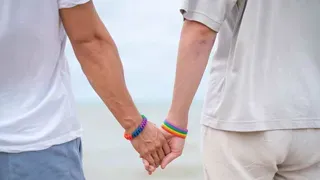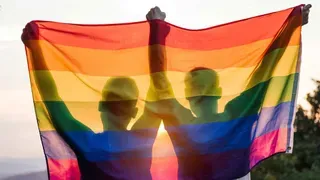August 29, 2014
Transwoman Nicole Bray's Documentary Will Follow Her Transition: Part II
Winnie McCroy READ TIME: 5 MIN.
In Part I of Nicole Bray's story, we learned how, after five years of marriage to a wonderful woman, Bray finally admitted in July 2012 that she had gender dysphoria, and wanted to become a woman herself.
Amazingly, her wife, family and friends were supportive and accepting of her decision, and within two years, Bray had made the transition. Now living happily as a woman, Bray, who is a filmmaker, wanted to share her story in an effort to inspire others living with gender dysphoria. Instead of committing suicide, like Bray nearly did, they can go through the steps to become the gender they believe they should have been born into, and live a happy, fulfilled life.
"There's always so much negative information out there about this process, but my story was positive," said Bray. "I got acceptance from my family and friends, my wife, and everything that could have gone right, did. I thought it was important to share our story, because I wanted people to know that being transgender wasn't a bad thing. It can be a success story."
So Bray set up a crowdfunding page on Indiegogo, with a goal of $30,000 to fund her final gender reassignment surgery, and to write, film and edit a yet-untitled documentary film about her journey. By the time the campaign finished this summer, she had raised $30,160 -- more than her goal.
"It was not my idea to crowdfund this money," said Bray. "I thought there was no way in the world anyone would want to donate to a cause like this. But my wife and mom pressed me to do it, and it surpassed my expectations."
While the campaign was underway, Bray outlined what she wanted to cover in the film: her experience with coming out and coping with the public in the midst of her transition, to pre-surgery preparations, post-op recovery and interviews with herself, her wife, family members and friends. Also, a psychologist specializing in working with the LGBT population will explain what transgender is, and some of the theories behind it. But much remains to be done.
"I am a filmmaker so initially I am doing pre-production, but I need to find a writer, producer and director to jump on board and collaborate with me," said Bray. "I'm still working on finding that team to help me. Doing an entire documentary alone is outside of my scope."
While Bray attempts to put together her "dream team" documentary film crew and assign a title to her film, she is also recovering from the final gender reassignment surgery, which was completed this August at the Gender Wellness Center Papillon in New Hope, Pennsylvania.
Her physician, Dr. Christine McGinn, is a transgender surgeon who underwent the operation herself, an aspect that is very appealing to Bray and other trans clients.
"If I wasn't doing this, I wouldn't be here today," said Bray. "My gender dysphoria was so severe, I lost track of how many times I've tried to commit suicide. My brain and body know what it is, and when that's a mismatch, it's quite a conflict."
Nearly 41 percent of transgender people attempt suicide -- more than 25 times the rate of the general population. They are often harassed at work or school, fired from their jobs, lose their homes, are denied medical care, become victims of physical and sexual assault, and are rejected by their family and friends.
Gender reassignment surgery isn't cheap; the Brays have already ponied up $60,000 of their own money to transition-related expenses, including facial electrolysis, hormone replacement therapy, voice therapy, counseling and facial feminization surgery. But, research shows that 99 percent of those who undergo gender confirming surgery are successful in ending their gender dysphoria and living a happy, healthy life.
Luckily, Bray hasn't had to undergo this transition alone. Her wife, Lori, has been right there by her side. She even wrote a note of support on the Indiegogo campaign, saying that, "I knew I needed and desired to support her transition from male to female so she could begin to live a fully authentic life!"
"We are still happily married today, and as a result, have already beaten many of the seemingly insurmountable obstacles to transition," said Lori Bray, who is writing a book about the experience, from a spouse's viewpoint. "Very few couples continue their marriage past their partner's coming out. However, we are unlike most couples."
Nicole Bray celebrates this, saying, "Contrary to what strangers may think, our marriage is the strongest it's ever been. It's the first time she's gotten to see the authentic, happy me."
Bray believes that her story has the potential to save lives. She has overcome the obstacles before her in a tale that she hopes will provide hope and guidance to other transgender individuals. And she plans to travel across the country sharing this story and giving presentations about what transgender is, to help people understand that these are real people who need to resolve the conflict between their brain and their body.
This documentary, hoped Bray, could help transgender individuals from becoming just another statistic.
For more information, visit https://www.facebook.com/NicolesStoryDoc?ref=br_tf
Winnie McCroy is the Women on the EDGE Editor, HIV/Health Editor, and Assistant Entertainment Editor for EDGE Media Network, handling all women's news, HIV health stories and theater reviews throughout the U.S. She has contributed to other publications, including The Village Voice, Gay City News, Chelsea Now and The Advocate, and lives in Brooklyn, New York.




